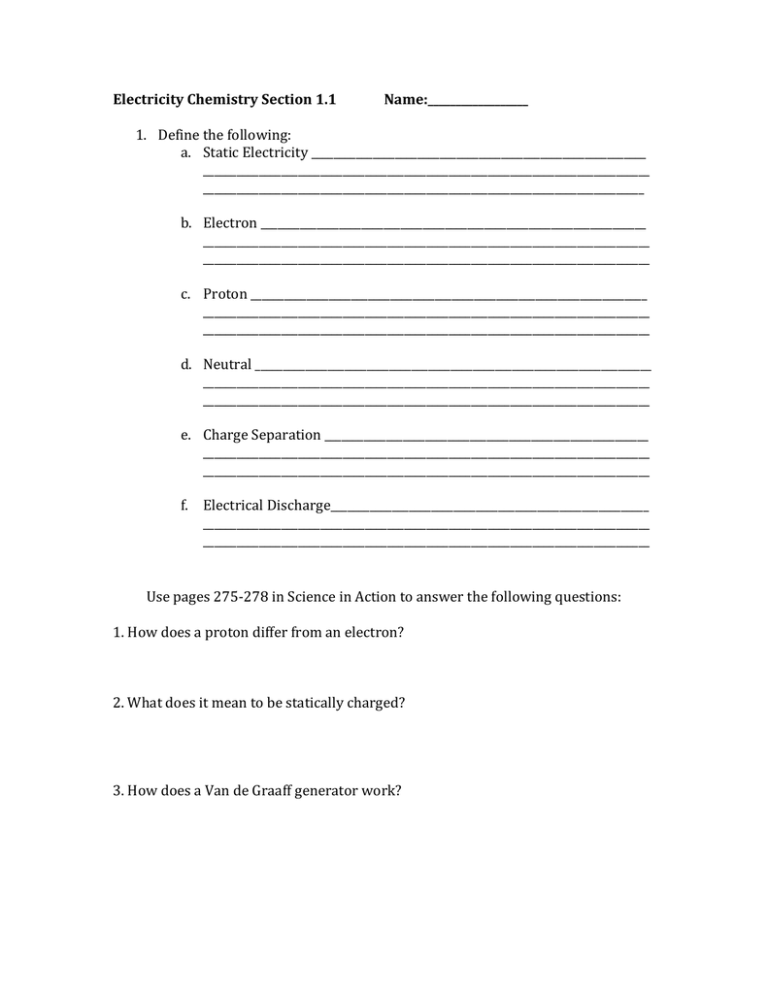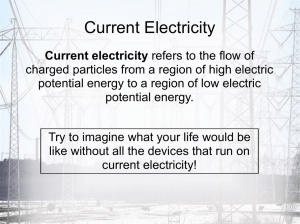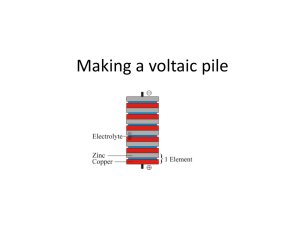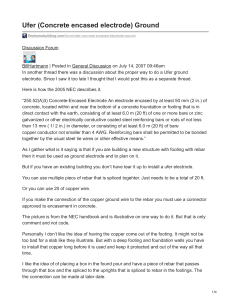Electricity Section 1 Booklet
advertisement

Electricity Chemistry Section 1.1 Name:__________________ 1. Define the following: a. Static Electricity ____________________________________________________________ ________________________________________________________________________________ _______________________________________________________________________________ b. Electron _____________________________________________________________________ ________________________________________________________________________________ ________________________________________________________________________________ c. Proton _______________________________________________________________________ ________________________________________________________________________________ ________________________________________________________________________________ d. Neutral _______________________________________________________________________ ________________________________________________________________________________ ________________________________________________________________________________ e. Charge Separation __________________________________________________________ ________________________________________________________________________________ ________________________________________________________________________________ f. Electrical Discharge_________________________________________________________ ________________________________________________________________________________ ________________________________________________________________________________ Use pages 275-­‐278 in Science in Action to answer the following questions: 1. How does a proton differ from an electron? 2. What does it mean to be statically charged? 3. How does a Van de Graaff generator work? 4. a)What happens when like charges interact? b) What happens when unlike charges interact? 5. You rub your feet across a floor and electrons transfer from you to the floor. Are you now negative or positively charged? 6. A neutral object contains no charge. Is this statement true? Explain. 7. Why is a neutral object attracted to a charged object? 8. Large trucks that carry flammable liquids often have a metal wire or chain that drags on the ground. Why? Section 1.2 1. Define the following a. Electrical Current ______________________________________________________ ____________________________________________________________________________ ____________________________________________________________________________ b. Circuit ___________________________________________________________________ ____________________________________________________________________________ ____________________________________________________________________________ c. Amperes _______________________________________________________________ ____________________________________________________________________________ ____________________________________________________________________________ d. Conductors _______________________________________________________________ ____________________________________________________________________________ ____________________________________________________________________________ e. load _____________________________________________________________________ ____________________________________________________________________________ ____________________________________________________________________________ f. Voltage ___________________________________________________________________ ____________________________________________________________________________ ____________________________________________________________________________ g. Electrical Energy ________________________________________________________ ____________________________________________________________________________ ____________________________________________________________________________ h. Potential Difference _____________________________________________________ ____________________________________________________________________________ ____________________________________________________________________________ i. Volt _______________________________________________________________________ ____________________________________________________________________________ ____________________________________________________________________________ j. Voltmeter ________________________________________________________________ ____________________________________________________________________________ ____________________________________________________________________________ Use pages 279-­‐283 in Science in Action to answer the following questions: 1. What is electrical energy? 2. How does current electricity differ from static electricity? 3. What is voltage? 4. What are the units for measuring a) current b) voltage 5. You require a high-­‐ current battery to start a large tractor. While shopping, should you be more concerned with the battery’s rating of volts or amps? Why? 6. A wire carrying more electrons will transfer more energy than a wire carrying fewer electrons. Is this true, why? 7. Using the diagram on page 280, describe how electricity gets from the generating plant to an appliance in your home. 8. What is the reading on the voltmeter on page 283? Section 1.3 1. Define the following: a. Short Circuit _________________________________________________________ ________________________________________________________________________________ ________________________________________________________________________________ b. Insulators ______________________________________________________ ________________________________________________________________________________ ________________________________________________________________________________ c. Fuses _____________________________________________________________________ ________________________________________________________________________________ ________________________________________________________________________________ d. Circuit Breakers _____________________________________________________________ ________________________________________________________________________________ ________________________________________________________________________________ 2. What is more dangerous, current or voltage? Why? 3. What is the purpose of a fuse? 4. What is meant by ground wire? 5. What is a short circuit? 6. A power line carrying a high current falls on a car, but the people inside are not electrocuted. Explain. 7. Are all electric shocks to the body dangerous? Explain. 8. Tall buildings often have a steel lighting rod that is connected to the ground with a wire. Lightning tends to strike these rods during storms. Why are these rods added and how do they work? 9. A friend has told you about plugging in a radio and putting it on the edge of the tub while taking a bath. Why is it unwise to listen to music this way? 10. Why is it a bad idea to take shelter under a tree in a thunderstorm? 11. You notice a friend removing the third prong of a plug so that the plug will fit into an extension cord that has only two holes. Is the removal of this third prong safe? Explain why or why not? Section 1.4 1. Define the following: a. Electrochemical cell ________________________________________________________ ________________________________________________________________________________ ________________________________________________________________________________ b. Dry cells _____________________________________________________________________ ________________________________________________________________________________ ________________________________________________________________________________ c. Electrolyte ___________________________________________________________________ ________________________________________________________________________________ ________________________________________________________________________________ d. Ion ___________________________________________________________________________ ________________________________________________________________________________ ________________________________________________________________________________ e. Electrodes ___________________________________________________________________ ________________________________________________________________________________ ________________________________________________________________________________ f. Wet Cells _________________________________________________________________ ________________________________________________________________________________ ________________________________________________________________________________ g. Primary Cells ________________________________________________________________ ________________________________________________________________________________ ________________________________________________________________________________ h. Rechargeable cells __________________________________________________________ ________________________________________________________________________________ ________________________________________________________________________________ i. Secondary cells __________________________________________________________ ________________________________________________________________________________ ________________________________________________________________________________ j. Battery __________________________________________________________ ________________________________________________________________________________ ________________________________________________________________________________ k. Electrolysis __________________________________________________________ ________________________________________________________________________________ ________________________________________________________________________________ l. Electrochemistry __________________________________________________________ ________________________________________________________________________________ ________________________________________________________________________________ m. Electroplating __________________________________________________________ ________________________________________________________________________________ ________________________________________________________________________________ 1. Examine the two dry cells on pages 288 and 294 of your textbook. Identify two major similarities and two major differences. 2. Draw one of the wet cells you saw demonstrated in class. Clearly label the electrolyte, and the two electrodes. 3. Explain in your own words how a rechargeable cell works. 4. List an advantage and disadvantage of both a dry cell and a wet cell: Advantage Disadvantage Dry Cell: Wet Cell: 5. Dry cells are designed to keep electrons flowing. Why do they eventually “die” or stop working? 6. A car designer has proposed building a new car battery. She is planning to test the following different electrode and electrolyte combinations. State whether her wet cell will work. a. b. c. d. e. f. Electrolyte Electrode #1 Electrode #2 Distilled Water Salt Water Lemon Juice Lemon Juice Salt Water Distilled Water Zinc Copper Zinc Zinc Carbon Carbon Zinc Copper Copper Carbon Carbon Copper Will it work (Yes or No) 7. Match each of the following examples: i. electrolysis ii. electroplating iii. anodizing iv. electrorefining a. _____ An electrode made of impure silver is dissolved into solution and collected on an electrode of pure silver. b. _____ A titanium carabiner used for rock climbing is strengthened by adding a layer of titanium oxide. c. _____ Electricity is used to obtain the elements hydrogen and oxygen from the splitting of molecules of water. d. _____ A steel exhaust pipe is coated with chrome





